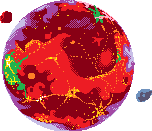Space Warfare
About Solaris | Guide to Solaris | Prologue
History
1st.First, the cost of space warfare is very high. Due to orbital mechanics, combat in space requires a lot of technology and specialized ship designs to take full advantage of available equipment. 2nd. Second, defenders' advantage. The difficult part of conquering another planetoid is in the disembarkment from space to the ground. Entrenched defenses have been difficult to destroy from space, particularly evidenced in the Catamite Wars. 3rd. Third, lack of motive. Not only are many planet and planetoid environments hostile to humanoids from other planetoids, further investments need to be made to extract any resources and move them from ground to orbit and back home. It has proven to be far easier to simply pay the inhabitants of a planet and engage in commerce. The Imperial Period of Mercury is one of the first examples of this kind of commerce.
Doctrines
The Future of War in Space
Space Forces
Mercury
Mercury was an early leader of system-wide trade, and did not have a standing fleet larger than a handful of fast cutters. What survives of its space force has been absorbed by Caduceus, while its massive merchant marine is scattered and is of little note in terms of military might.Venus
Venus has no moons, is far from the Sol System's belts, and has had cooperative relationships with its neighbors Mercury and Mars. Despite this fact, it has invested in a small and atypical space force of missile cruisers alongside the usual complement of patrol boats. Combined with her merchant marine, it is likely that Venus will be of help to Mars in the event of space conflict.Mars
Mars has the second largest fleet in the Sol System and has quickly emerged as a rival space power to Jupiter. The Mars Homefleet is Mars's unified front, funded by all of Mars's nations and operating as a single fleet. It is composed of three carriers similar in capability to the Pater-class, along with a whole host of cruisers and tenders that could theoretically enable the Homefleet to operate far outside of friendly space. Mars also employs minelayers armed with stealth mines, defense platforms, and is rumored to even have full stealth warships.Asteroid Belt
The Belt consists of a series of settlements and outposts that claim sovereignty but are unrecognized by either Mars or Jupiter. After those two planets clashed over the control of the Belt, deploying military vessels and flying provocative patrols in the name of pirate-hunting, many Belter groups have joined together to organize their own defense force. Belter military ships are usually converted civilian vessels with makeshift weaponry, but its crew are highly motivated to defend their home.Jupiter
Jupiter easily has the largest fleet in the Sol System, though it also has the busiest orbit as well. Its Orbital Guard has consistently operated at least twelve carriers, a host of space superiority craft, fast cutters, and more recently space surveillance craft. The Orbital Guard is constantly chasing pirates that the Jovians claim is Saturn-sponsored. Separately from its established carrier fleet, there are allegations that Jupiter is attempting to build some kind of supercarrier in direct and flagrant contravention of the Alliance of Nations conventions of disarmament.Saturn
Although Saturn and her moons have enough collective economic power to field a space force to rival Mars or even Jupiter, it does not have the political unity to do so. Merchant Princes are loathe to cooperate with each other on matters of power-sharing, and the largest of the Princes have built up sizeable fleets of small military craft that are used to sabre rattle, though small engagements have been known to happen. It is known that even smaller Princes own and operate defensive platforms, but it is nearly impossible for anyone to tally all such installations in the chaotic and unregulated orbit of Saturn.Uranus
Uranus is primarily composed of city-states and city-state alliances. Starwatch is its collective defense organization, but its main focus is on the Sentinel program and patrolling the skies of Uranus to deter atmospheric raiders. This means that most of its military infrastructure is either pointed inwards, such as observation posts that attempt to peer through Uranus's cloud layers, or outwards towards the Kuiper belt, including long range sensors and telescopes. Little attention is paid to patrolling its orbit, with some fast cutters its only mobile space military presence.Neptune
The Neptunian Trident Empire has a massive fleet, but it is technologically primitive and scattered across the entire Sol System and the Kuiper Belt. Hailing from her golden age, the Trident Fleet helps maintain the Empire's control over its outlying colonies and provides logistical capabilities which improve Neptune's extra-solar threat posture alongside the Sentinel program. In a modern conflict, military analysts from Mars and Jupiter agree that the Trident Fleet is unlikely to be a relevant player in any situation.| Crystal Technology | ||||||||
|---|---|---|---|---|---|---|---|---|
|

















I really like that you went into detail about why space warfare hasn't been too common in the past, but also you managed to have quite the ominous tone about the future. Fun overview of the planets and their fleets, too. Jupiter needs to calm down.
Explore Etrea
Jupiter has something to prove and a whole lot of money to throw at it...